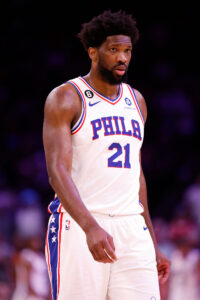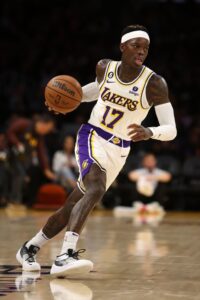By the end of the night on Tuesday, two more first-round playoff matchups will be locked in, with the No. 7 seeds in both conferences having been determined.
[RELATED: NBA’s Play-In Field, Top-Six Playoff Seeds Set]
The Eastern Conference’s No. 7 vs. No. 8 matchup pits Jimmy Butler and the 44-38 Heat against Trae Young and the 41-41 Hawks. The two Southeast clubs will do battle on Tuesday at 7:30 pm Eastern time in Miami for the right to face the second-seeded Celtics in the first round.
Miami is the home team in this game, won the season series with Atlanta (3-1), and will enter as a 4.5-point favorite, per BetOnline.ag. The Heat haven’t looked as good this season as they did in 2021/22, when they claimed the top seed in the East and came within a couple plays of making the NBA Finals. But they’re as healthy now as they’ve been at any time this season and were far better at home (27-14) than on the road.
Miami has also done a good job defending Young — his 19.8 points per game on .356/.208/.865 shooting in four games this season vs. the Heat were the worst numbers he put up against any Eastern Conference team.
Atlanta, meanwhile, has been the epitome of a .500 club this season. Since going 13-13 in their first 26 games, the Hawks have had a .500 record an incredible 22 more times en route to a 41-41 finish.
Still, like the Heat, the Hawks are healthy entering Tuesday’s play-in game. They’ve been a winning team (38-35) when Young is available and have been a little more effective under head coach Quin Snyder (+1.8 net rating) than they were under Nate McMillan (-0.5). Perhaps Atlanta will also benefit from past play-in experience — the club won two play-in games a year ago to claim the No. 8 seed in the East.
Over in the West, the No. 7 Lakers (43-39) will host the No. 8 Timberwolves (42-20) in the second play-in game of the night to determine which team will advance to the playoffs and face the Grizzlies in round one.
The Lakers are eight-point favorites and it’s not hard to see why. Since their trade-deadline additions debuted on February 11, the Lakers have the NBA’s sixth-best net rating (+4.8) and third-best record (18-8), despite missing star forward LeBron James for 13 of those games. They’re playing their best basketball of the season at exactly the right time.
The Timberwolves, on the other hand, are entering the play-in tournament with their huge 2022 offseason addition – Rudy Gobert – set to serve a one-game suspension after punching a teammate on the sidelines in Sunday’s regular season finale. Meanwhile, breakout All-Defensive candidate Jaden McDaniels, whom the Wolves insisted on keeping when they dealt for Gobert, will be sidelined due to a separate punch — this one, aimed at a wall, broke McDaniels’ hand.
With Naz Reid (wrist surgery) also unavailable and Karl-Anthony Towns (right calf strain) listed as questionable, the Wolves will be the shorthanded team on Tuesday, but it’s worth noting that amidst all their drama and injuries, they pulled off an impressive comeback win over New Orleans on Sunday to claim the eighth spot in the West. Maybe the turmoil will help the team come together and pull off an upset victory in Los Angeles.
We want to know what you think. Which two teams will win tonight’s games and claim the No. 7 seeds for the playoffs?
Vote in our poll below, then head to the comment section below to share your thoughts!
 The results of four games today will determine which clubs end up holding the Nos. 5-9 seeds in the West. Those games are as follows:
The results of four games today will determine which clubs end up holding the Nos. 5-9 seeds in the West. Those games are as follows: Embiid’s final line included 52 points, 13 rebounds, and six assists on 20-of-25 shooting. He was a plus-17 in nearly 39 minutes. The 76ers were outscored by 15 points in the nine-plus minutes he didn’t play.
Embiid’s final line included 52 points, 13 rebounds, and six assists on 20-of-25 shooting. He was a plus-17 in nearly 39 minutes. The 76ers were outscored by 15 points in the nine-plus minutes he didn’t play. Frankly, the race for the playoffs in the East would have been more exciting under the NBA’s old system, where only the top eight seeds at the end of the regular season made the playoffs. Currently, the Hawks and Raptors are tied for the No. 8 spot at 39-39 (Atlanta has the tiebreaker advantage), while the Bulls are one game back at 38-40. It’s a safe bet that all three teams will make the play-in tournament, whereas in past years they would’ve been fighting for a single playoff spot.
Frankly, the race for the playoffs in the East would have been more exciting under the NBA’s old system, where only the top eight seeds at the end of the regular season made the playoffs. Currently, the Hawks and Raptors are tied for the No. 8 spot at 39-39 (Atlanta has the tiebreaker advantage), while the Bulls are one game back at 38-40. It’s a safe bet that all three teams will make the play-in tournament, whereas in past years they would’ve been fighting for a single playoff spot. Before the 2022/23 season started, Schröder said he had “
Before the 2022/23 season started, Schröder said he had “ There’s nothing about Brown’s game that really jumps out at you, nor do his modest numbers — he’s averaging 7.3 PPG, 4.1 RPG and 1.2 APG in 70 games (45 starts, 24.9 MPG).
There’s nothing about Brown’s game that really jumps out at you, nor do his modest numbers — he’s averaging 7.3 PPG, 4.1 RPG and 1.2 APG in 70 games (45 starts, 24.9 MPG). May 16: NBA draft lottery
May 16: NBA draft lottery